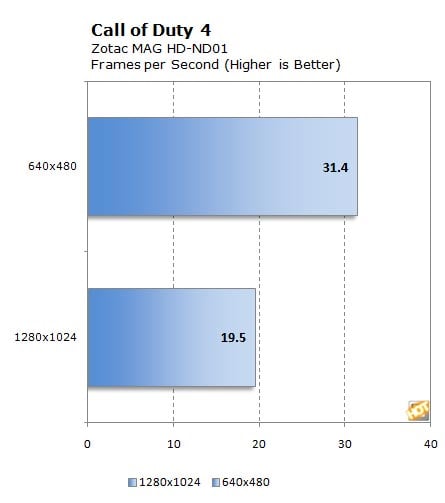Small Wonder: Zotac's HD-ND01 Nettop Review
| |
|
Torchlight is a recently released 3D action/adventure RPG strongly rooted in the original Diablo—if you close your eyes and listen to the musical score, you'll almost swear you're back in Tristram, with Deckard Cain inviting you to "Stay awhile, and listen." More importantly for our purposes, Torchlight is a modern game that's fun, good-looking, and has modest system requirements. Intriguingly, Torchlight also offers a "Netbook Mode" under its "Settings" menu. One click, and the game closes and reloads itself with a distinct set of pre-selected GPU features activated. It's not clear if this option also changes anything about how Torchlight caches level data or creature rendering, but it's a great option to have in-menu.
Torchlight doesn't require high frame rates; the Zotac's 23.7 fps rate listed below means that in practice, the game ran smoothly with a discernible slow-down when huge numbers of mobs were on the screen (but no hiccups or outright stuttering.)

Unlike some of the other games we tested, Torchlight ran and rendered normally on Intel's GMA 950, but we can't say it ran particularly well. 7.3 fps is acceptable for running around in town, but as soon as the action gets heavy in a dungeon map, the framerate falls to 4-5 fps. Framerates also plunge when entering new areas, or when subterranean levels become visible below the area you're currently exploring. (Torchlight uses this trick to give the impression of depth within the game—the areas you see below don't actually correspond to the level you'll find.) Lowering the resolution to 640x480 didn't help the Asus board—framerates remained identical, which suggests that the performance bottleneck here is either related to the size of the GPU framebuffer or Atom's inability to quickly perform certain calculations in software that ION is handling in hardware.
 |
|
Call of Duty 4 is a first-person-shooter in the popular Call of Duty series that puts you in the shoes of military personal from both the US and Britain in a modern setting rather than the World War II locales the games have become synonymous with. We play through the "Game Over" mission in Act III. Because this mission takes place on a rail (with the character required to maintain focus on certain areas in order to clear them), it's easier to guarantee that multiple playtests will render nearly identically. Unfortunately, we ran into a bit of a snag with this one—the Intel GMA 950 isn't capable of running Call of Duty 4 because it lacks the necessary hardware vertex shaders. There are applications out there that can trick games into thinking the vertex hardware exists while performing the necessary calculations on the CPU, but Atom doesn't have the computational power to spare for this approach.
Instead of comparing the MAG HD-ND01 against the Asus, therefore, we compared it to itself. The game benchmark was run at two separate resolutions and detail settings. For 1280x1024, we disabled all optional settings (Shadows, Specular Mapping, Ragdoll, Bullet Impact, etc) and turned all tune-able options down as far as they could go. We opted for trilinear filtering, but kept texture details set to "Low." In 640x480 we kept the optional settings off, but raised model detail, water detail, and texture detail to normal.

 |
|
Left 4 Dead is a co-operative, survival horror, first-person shooter that was developed by Turtle Rock Studios, which was purchased by Valve part-way into development. Like Half Life 2, the game uses the Source engine, however, the visuals in L4D are far superior to anything seen in the Half Life universe to date. The game pits four survivors of an apocalyptic pandemic against hordes of aggressive zombies.

After Call of Duty 4 refused to run on Intel's GMA 950 we were surprised to see that Left 4 Dead was willing to launch and enter the game. To Valve's credit, when they built the Source engine, they baked in flexibility—games will often fall back to earlier DirectX levels seamlessly when confronted with hardware that doesn't support certain feature sets. In this case, the feature set when playing Left 4 Dead on an Intel platform + Atom is so different, we're nearly playing a different game.


Do battle against a fearsome horde of rejected Quake models!






